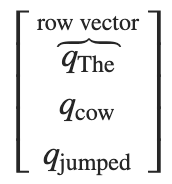1、序列模型和长期记忆网络
至此,我们已经看到了各种前馈网络。即,网络根本不维持任何状态。这可能不是我们想要的行为。序列模型是NLP的核心:它们是在输入之间存在一定时间依存关系的模型。序列模型的经典示例是用于词性标记的隐马尔可夫模型。另一个示例是条件随机场。
递归神经网络是维持某种状态的网络。例如,它的输出可以用作下一个输入的一部分,以便信息可以随着网络在序列上传递而传播。对于LSTM,对于序列中的每个元素,都有一个对应的隐藏状态 ht,原则上可以包含序列中任意点的信息。我们可以使用隐藏状态来预测语言模型中的单词,例如词性标签,槽位识别。
2、Pytorch中的LSTM
Pytorch的LSTM输入一般为3D张量。第1维为词数,第2维为batch数,第3维为词向量的维度。LSTM的原理可以看博客循环神经网络。如果我们想对句子“ The cow jumped”运行序列模型,我们的输入应如下所示

#LSTM依赖的数学函数及输入输出参数详解
lstm=nn.LSTM(3,4,2) #输入维度3,输出维度3,层数2
'''
nn.LSTM将多层长短期记忆(LSTM)RNN应用于输入顺序。
对于输入序列中的每个元素,每一层计算以下内容
对应的数学函数:
math::
\begin{array}{ll} \\
i_t = \sigma(W_{ii} x_t + b_{ii} + W_{hi} h_{t-1} + b_{hi}) \\
f_t = \sigma(W_{if} x_t + b_{if} + W_{hf} h_{t-1} + b_{hf}) \\
g_t = \tanh(W_{ig} x_t + b_{ig} + W_{hg} h_{t-1} + b_{hg}) \\
o_t = \sigma(W_{io} x_t + b_{io} + W_{ho} h_{t-1} + b_{ho}) \\
c_t = f_t \odot c_{t-1} + i_t \odot g_t \\
h_t = o_t \odot \tanh(c_t) \\
\end{array}
:math:`h_t` 表示`t`时刻的隐藏状态, :math:`c_t`表示`t`时刻的cell状态,
:math:`x_t` 表示`t`时刻的输入,
:math:`h_{t-1}`表示`t-1`时刻的隐藏状态或者初始状态
math:`f_t`,:math:`g_t`,:math:`o_t`分别表示输入,遗忘、cell、输出门
:math:`\sigma`表示sigmoid 函数, :math:`\odot` Hadamard乘积.
Args:
input_size:输入x的特征维度
hidden_size:处于隐藏状态“h”的特征维度
num_layers:循环图层数。例如,设置``num_layers = 2``意味着将两个LSTM堆叠在一起以形成“堆叠的LSTM”,
第二个LSTM接收第一个LSTM的输出,计算最终结果。默认值:1
bias:如果为False,则该图层不使用偏见权重“ b_ih”和“ b_hh”。默认值:``True``
batch_first:如果为``True'',则提供输入和输出张量作为(批次,序列,特征)。默认值:``False''
dropout:如果非零,则在每个输出的输出端引入一个“ Dropout”层LSTM层(最后一层除外),丢失概率等于attr:`dropout`。默认值:0
bidirectional:如果为``True'',则变为双向LSTM。默认值:``False''
Inputs: input, (h_0, c_0)
- input张量的shape为 `(seq_len, batch, input_size)`: 张量包括了输入序列的特征
- h_0张量的shape为`(num_layers * num_directions, batch, hidden_size)`: 张量包含了每一batch中初始隐藏状态
如果LSTM是双向的, num_directions为2, 否则为1.
- c_0张量的shape为 `(num_layers * num_directions, batch, hidden_size)`: 张量包含了每一batch中初始cell状态
如果`(h_0, c_0)` 未提供, h_0,c_0默认为全0张量
Outputs: output, (h_n, c_n)
- output张量的shape为`(seq_len, batch, num_directions * hidden_size)`:张量是LSTM最后一层每个t时刻o_t
如果class:`torch.nn.utils.rnn.PackedSequence` 已经作为输入给出,输出也将是packed序列。对于unpacked的情况,可以将方向分开
使用``output.view(seq_len,batch,num_directions,hidden_size)``,
前进和后退分别是方向“ 0”和“ 1”。
- h_n张量的shape为`(num_layers * num_directions, batch, hidden_size)`: 张量是LSTM最后一层t(t = seq_len)时刻h_t隐藏状态
可通过h_n.view(num_layers, num_directions, batch, hidden_size)获取每层隐藏状态。
- c_n张量的shape为`(num_layers * num_directions, batch, hidden_size)`: 张量是LSTM最后一层t(t = seq_len)时刻c_t状态
'''
inputs=[torch.randn(1,3) for _ in range(5)] #构建一个句子长度为5,维度为3的输入句子,一个batch的数据
#初始化隐层状态和cell状态 hidden输入维度(num_layers * num_directions, batch, hidden_size)
hidden = (torch.randn(2, 1, 4),
torch.randn(2, 1, 4))
'''
before: 1 tensor([[[ 0.0645, -0.1050, 0.1427, -0.0289]]], grad_fn=<StackBackward>) (tensor([[[ 0.0465, 0.0638, 0.3326, -0.2273]],[[ 0.0645, -0.1050, 0.1427, -0.0289]]], grad_fn=<StackBackward>), tensor([[[ 0.0992, 0.2878, 0.9721, -0.4657]],[[ 0.1024, -0.3557, 0.6139, -0.0391]]], grad_fn=<StackBackward>))
after: 1 tensor([[[ 0.1458, -0.0954, 0.1286, 0.1728]]], grad_fn=<StackBackward>) (tensor([[[ 0.0157, 0.2103, 0.2820, -0.2021]],[[ 0.1458, -0.0954, 0.1286, 0.1728]]], grad_fn=<StackBackward>), tensor([[[ 0.0302, 0.6760, 0.6505, -0.4757]],[[ 0.2552, -0.2182, 0.3291, 0.3289]]], grad_fn=<StackBackward>))
'''
for i,input_x in enumerate(inputs):
input_x=input_x.view(1,1,-1)
if i==0:
input_all=input_x
else:
input_all=torch.cat((input_all,input_x),dim=0)
out,hidden=lstm(input_x,hidden)
print("after:",i,out,hidden)
print(input_all.size())
out,hidden=lstm(input_all,hidden)
print('all seq',out,hidden) #out:seq_len*hidden_dim 3、LSTM用于词性标记
目前使用LSTM实现词性标注的实例,目前未使用Viterbi或Forward-Backward之类的算法。在此处会使用词向量,实现参考pytorch之词嵌(三)
流程如下:输入句子为 w1,…,wM。wi∈V,T 是标签集,yi 对应单词的标签wi,对单词标签wi 的预测为ŷi。
预测序列为 ŷ1,…,ŷM; ŷ i∈T。
预测目标函数为:
![]()
#词性标注LSTM使用实例
def word2id(data,w2i):
for ws,tag in data:
for w in ws:
if w not in w2i:
w2i[w]=len(w2i)
#词性标注数据
train = [
("The dog ate the apple".split(), ["DET", "NN", "V", "DET", "NN"]),
("Everybody read that book".split(), ["NN", "V", "DET", "NN"])
]
w2i={}
t2i={"DET": 0, "NN": 1, "V": 2}
word2id(train,w2i)
EMBEDDING_DIM = 6
HIDDEN_DIM = 6
class LstmTag(nn.Module):
def __init__(self,embedding_dim,hidden_dim,vocab_size,tag_size):
super(LstmTag,self).__init__()
self.embedding=nn.Embedding(vocab_size,embedding_dim)
self.lstm=nn.LSTM(embedding_dim,hidden_dim)
self.lstm2tag=nn.Linear(hidden_dim,tag_size)
def forward(self,x):
embeds=self.embedding(x)
o,h=self.lstm(embeds.view(len(x),1,-1))
tags=self.lstm2tag(o.view(len(x),-1))
tags_prob=F.log_softmax(tags)
return tags_prob
model=LstmTag(EMBEDDING_DIM,HIDDEN_DIM,len(w2i),len(t2i))
loss_function=nn.NLLLoss()
opt=optim.SGD(model.parameters(),lr=0.1)
for input_x,y in train:
ids=torch.tensor([w2i[w] for w in input_x],dtype=torch.long)
targets=torch.tensor([t2i[w] for w in y],dtype=torch.long)
probs=model(ids)
print(probs)
loss=loss_function(probs,targets)
loss.backward()
opt.step()
print(loss)